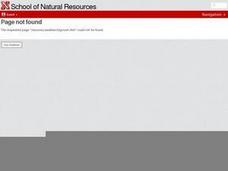Curated OER
Barometer Investigation
Students construct a barometer to use in an experiment that they design to measure the air pressure on a daily basis. These observations of air pressure allow students to determine how weather is affected when a storm is approaching and...
Curated OER
You Can Take the Pressure!
Young scholars construct and use a barometer over a period of 1-2 weeks to investigate and predict upcoming weather from barometric pressure.
Curated OER
Comparing Temperature, Pressure, and Humidity
Students investigate data on temperature, pressure, and humidity by downloading information from the ARM Website. Working in groups, they discover how weather impacts life in each of the ARM sites. They record weather data in their...
Curated OER
Meteorology Madness
Students probe the dynamic weather changes through several hands-0n activities in this seven lessons unit. The hydrologic cycle, clouds, atmosphere, air movement, fronts, and forecasting form the components presented in this unit.
Curated OER
Tracking the Weather
Students observe weather patterns. In this weather lesson, students track weather trends and predict what the weather might be like in the upcoming forecast. Students learn to apply concepts of barometric pressure and how weather may be...
Curated OER
Weather Watchers
Students engage in this weather predicting instructional activity. They discover instrumentation used in the meteorological science. With this knowledge, they will create their own "low-tech" versions of weather instrumentation such as...
Curated OER
Air Pressure is Powerful
Students construct a barometer and collect data on the changes in air pressure. They work is small groups using plastic tubing, corks, and green food coloring. They then use a formula to convert inches of mercury to barometric pressure...
Curated OER
Using a Barometer to Measure a Building:
Young scholars show how it is possible to determine the height of a
tall building with the aid of a barometer. They Take the barometer to the top of
the building, attach a long rope to it, lower the barometer to
the street and then...
Curated OER
Learning Lesson: Measure the Pressure -- The "Wet" Barometer
Students use simple objects to create their own barometer. They have five days to build it and ten days to observe and collect data. They examine thunderstorm safety tips to end the lesson.
Curated OER
Learning Lesson: Measure the Pressure II -- The "Dry" Barometer
Learners use simple items to create their own aneroid barometer. They have five days to build it and ten days to observe and collect data. They examine tornado safety tips to end the instructional activity.
Curated OER
Today's Weather on Mars
Students investigate the temperature and wind data locally, nationally, and internationally and compare these conditions to those on Mars. Conclusions are drawn about the differences of these conditions and the causes for the variance...
Curated OER
The Big Crush
Students examine weather maps from their state from the past few days. They examine the Highs and Lows on the maps to determine what kind of weather they produce. They use that information to better prepare for their activities and what...
Curated OER
Beaufort Wind Speed
Fourth graders investigate temperature, wind speed, humidity, air pressure, and direction. They compare their findings with those of the media. They apply the use of various tools to measure weather factors.
Curated OER
Air Expansion and Contraction
Students observe that air exerts pressure, that heated air expands and that cooled air contracts. After the demonstration, students engage in a question and answer session about what they saw.















